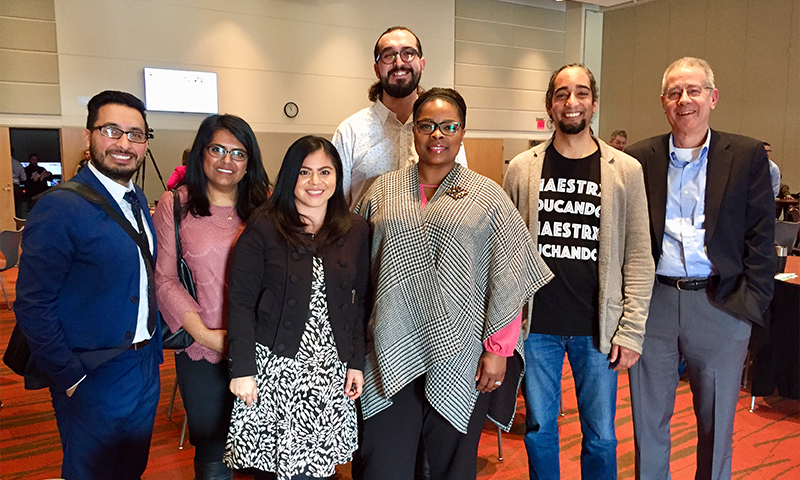Dr. Hans Andrews is Distinguished Fellow in Community College Leadership and former President of Olney Central College in Illinois. He was also a Dean of Instruction and Vice President of Community and Student Services at two other community colleges in Illinois and Michigan. He was an adjunct faculty member at Illinois State University.
Dr. William ‘Bill’ Marzano is a former academic administrator at Waubonsee Community College in Illinois. He started his community college service as a psychology instructor at Illinois Valley Community College. Between his two community college careers he served as a Vice President of Human Resources in the private sector.
Michele Needham is the Executive Director of Human Resources at Waubonsee Community College. She was a doctoral candidate at the University of Illinois in the Community College Leadership Program.
The community college system in the United States has evolved and gone through various stages of growth over the past sixty plus years. With those changes, the hiring practices for college presidents have also evolved and changed.
First wave of leaders evolved from various sources
Junior colleges, which were small in numbers from the 1920’s through the mid-1960’s, were known for successfully preparing students through the first two years of baccalaureate degrees.
New community colleges began springing up across the country in the 1960’s and were becoming known as the people’s colleges. This period of growth included the development of state systems for community colleges and provided leadership in terms of funding, campus location decisions and curriculum and budget development.
Community colleges were opening at a pace of one per week and enrollments were skyrocketing. Female and minority student enrollments were starting to grow at somewhat rapid rates. Being close to the people within each college district made higher education opportunities available at low costs and closeness to the homes of the students. This growth in institutions was cause for seeking out and starting to develop presidential leaders.
Vaughn (1986) studied the role of community college presidents. His national survey listed how community college presidents were recruited during this early period:
- 24 percent came from public school administration positions
- 15.2 percent came from four-year institutional positions
- A number moved from state level positions and boards.
Second round of presidents in the 1970’s
The growth of new community colleges began slowing down in the 1970’s and enrollments began to stabilize. Across the country the community colleges began expanding from their traditional role of offering transfer programs to universities and other four-year colleges. This expansion now included the following:
- Vocational and technical certificate and associate degree programs
- Continuing education courses and evening classes both on and off campus
- Weekend classes
- College courses and vocational certificate programs in county jails and state prisons
A new area of community service outreach in the 1970’s included working with community agencies, businesses and industries within each college district. This started bringing in a much more diversified student body. Some classes were offered in neighborhood churches, secondary schools and other community agency facilities.
Shifting backgrounds of presidents
George Vaughn (1986) conducted a national study that found background experiences had been shifting and new presidents were being selected as follows:
- 90 percent were coming from within the institutions
- 7 percent came from the public schools
- 4.7% came from four-year institutional positions
- 1.7 percent came from state-level positions
Embedded in the 90 percent of new presidents being groomed from within the institutions were the following:
- Academic deanships provided the most prevalent pathway.
- Other internal workers came from division chair positions, continuing education, community services and student services.
- The Kellogg Foundation during the 1960’s funded a ‘Kellogg Fellows’ program at 12 major American universities to educate future community college leaders.
Many eventually became presidents. Universities were beginning to expand their masters’ and doctoral degree programs around community college areas of study.
Third wave: Mentoring, training and advancement within
A third generation of leaders is now emerging to become presidents and/or other executive level administrators. These candidates can now benefit from the American Association of Community College’s leadership guide. It is known as The Competencies for Community College Leaders (2018) and outlines the major skills necessary as candidates are moving through each leadership level.
In addition, many institutions are leveraging more of their own resources to provide training for their internal future leaders. Community College Leadership Academies have also recently been developed in a number of states.
These experiences will put the applicants for the top positions with vastly improved leadership training than previously available.
Diversity of college leaders and faculty in many places do not presently match the diversity within their student bodies. Work in developing institutional strategic plans to help close these gaps is underway in many institutions…
___________________________________
 Image 1: Upcoming Mid-Level Waubonsee Community
Image 1: Upcoming Mid-Level Waubonsee Community
College Leaders at an in-service training session
__________________________________
Key Focus Areas – The following is a list of five key areas which future presidential candidates should be able to provide evidence in terms of knowledge and experience:
- Providing quality faculty in every classroom – Recruiting, hiring, and ensuring the professional development of a diverse and highly competent faculty is a key requirement.
- Recognition for teaching excellence is important but found lacking in over 50% of community colleges in a national survey a few years ago.
- Improving Success and Graduation Rates – Graduation rates were improved in Associate Degree and Certificate programs by 61% when one college, Illinois Valley Community College, involved all faculty, student service staff, and department and division administrators (Andrews, 2021):
Certificates awarded grew from 122 to 315 for a 258% increase
Associate Degrees awarded grew from 417 to 556 for a 33.3% increase
Total number of Certificates/Associate Degrees grew in total from 539 to 871
- Follow-up of graduates – One of the fifty Illinois community colleges followed their graduates at Illinois State University, where the largest number of their associate degree graduates transferred (Andrews, 2020). The follow-up over a seven year period revealed that their graduates had the highest grade point averages of the fifty state community colleges in 12 of the 14 semesters. These data pointed to the impact of quality instruction supported by a robust evaluation system.
- Dual-credit growth – The dual-credit programs have expanded from general education courses to include technical and vocational courses. Students are able to complete one-semester, one-year, or two-years with the completion of an Associate Degree at the same time of their secondary school graduations.
_______________________

Image 2: Dual-Credit Associate Degree Students:
Six seniors from Marquette Academy in Ottawa, Illinois, receiving their Associate Degrees and High School Diplomas at the same time.
________________________________
Conclusion:
Individual community colleges, as well as state community college systems, continually face an evolving challenge of selecting and preparing a new generation of college leaders to become their next top administrators and college presidents. Preparing a diverse leadership at this time will best lead these colleges in meeting the needs of a new generation of diverse learners!
_____
AACC Competencies for Community College Leaders. (2018, 3rd Edition). American Association of Community Colleges. Washington, D.C.
Andrews, H.A. (2021, September 23). An ‘Institution-Wide approach to improving graduation rates for high education institutions. Higher Education Digest, Independent Higher Education Portal Magazine. India.
Vaughn, G.B. (1986). The Community College Presidency. New York, Macmillan Publishing Company; 27-34.




